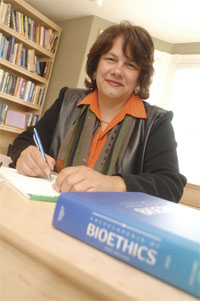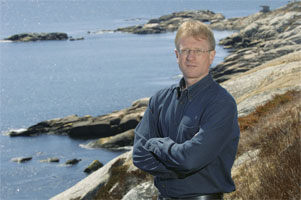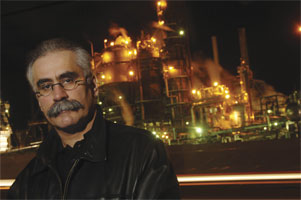Probing the microbe
 |
| Ford Doolittle. (Danny Abriel Photo) |
Microbes deserve more respect. These microscopic organisms defy basic science when it comes to species identification. They also play a critical role in maintaining the earthās biosphere and evolve very differently than plants or animals.
And they fascinate Ford Doolittle, Dalhousieās Canada Research Chair in Comparative Microbial Genomics. āUnlike humans, a species that evolves through gene mutation, bacteria are able to transfer genes laterally to adapt to their environment.ā Their fluidity and adeptness in taking on new genes needed to survive poses great danger to the long-term effectiveness of antibiotic treatment. It also makes it very difficult to decide just what makes up a bacterial species.
While these organisms are challenging fundamental concepts in genealogy and the ways living things evolve, they will also play a host of relevant roles when it comes to global warming. āMicrobes recycle and metabolize substances in the atmosphere,ā explains Dr. Doolittle. This is essential for the long-term survival of all life, our own included, but there is much that we donāt understand, and desperately need to.
āIt will be sad if the polar bears die off or get misplaced due to the melting of the Arctic ice cap. It may be disastrous if the permafrost melts, bringing to active life the vast community of methane-producing microbes currently mostly dormant in that environment. The time is ripe to try to understand the biological, ecological and environmental impacts of microbes as they relate to the basics of the biosphere.ā
Digging deep
 |
| Grant Wach. |
While many people today are heading mid-profession to Fort McMurray, Alberta, itās where Grant Wach began his geology career almost 30 years ago. He still works with the energy industry, but today, in his capacity as professor of petroleum geosciences and director of energy at pilipiliĀž», he now serves as a mentor, helping students become pilipiliĀž»ful geologists and engineers
āMy students and I recently went to the Guadalupe Mountains in Texas, where we examined an ancient fossil reef similar to one offshore Nova Scotia that will produce gas through the Deep Panuke project,ā says Dr. Wach. In Barbados and Trinidad, he and his research students are completing detailed analyses of rocks that are similar to the Sable gas fields.
Fieldwork not only makes better geologists or engineers, it appeals to students worldwide.āOur undergraduates spend more than 70 days of their studies in the field looking at the rocks,ā says Dr.Wach.āWe attract graduate students from across Canada, the United States, Trinidad, Norway, Libya, Iraq and Pakistan to our research group.ā
Asking challenging questions
 |
| Francoise Baylis. |
As a philosopher and ethicist,Ā FranƧoise Baylis, Dalhousieās Canada Research Chair in Bioethics and Philosophy, applies her ethics expertise to assisted human reproduction, embryo research, stem cell science and neuroscience. Scientific and technical advances in each of these areas are poised to radically transform health care and introduce new possibilities for human enhancement.
āBy stirring the gene pool you could create new kinds of beings. It is now possible to imagine a future in which deliberate human selection significantly alters the genetic makeup of our species,ā says Dr. Baylis.Ā Her novel perspectives on these types of issues are valued by some of the countryās top policy-makers. She was recently named to the Board of Assisted Human Reproduction Canada, a federal agency chaired by Nova Scotiaās former premier, Dr. John Hamm.
āDeveloping good public policy is difficult,ā says Dr. Baylis.āOur policies stand as public statements of who we are and what we value. If our policies disproportionately harm disadvantaged groups then they are flawed and should be changed.ā
Decreasing childrenās pain
 |
| Christine Chambers with Claudia Watt. |
As Dalhousieās Canada Research Chair in Pain and Child Health, Christine Chambers has a goal to decrease suffering in children and increase their ability to cope.
She is finding that sleep, or more specifically the lack of it, may hold the key to some of the recurring pains like headaches and stomach aches experienced by many teens today. She also studies two other areas: pain assessment tools and the role of family in pain.
One of her most surprising findings is that parental reassurance actually has a negative impact on children. āIf a child is having blood drawn, many parents offer reassurance telling them that āit wonāt hurt,āā explains Dr. Chambers.āWe have found that this increases the childās distress.ā Distraction and humour are much more effective in alleviating pain.
Dr. Chambers has also found that children are terrible at faking pain but are fabulous at hiding it.āA childās ability to hide pain is problematic, especially for those who have undergone a number of medical procedures (and want to avoid more) or donāt want their parents to worry about them.ā
Ultimately, she hopes to improve pain assessment and treatment effectiveness for children.āWeāve come a long way since the 1970s and 1980s, when it was thought that infants didnāt feel pain and were operated on without the use of pain-relieving drugs.As we learn more, we can direct public policy around pain management systems for kids. Overall, this bodes well for children, their families and the health care system.ā
Turning powder into products
 |
| Paul Bishop. |
The long-time tradition of die-casting metallic material into components of a desired shape and mechanical performance has a challenger. Over the last decade a more efficient, more precise process has surfaced. Known as āpowder metallurgy,ā it involves taking metallic powder and pressing it directly into the desired shape of the finished product, a process Paul Bishop says has the potential to save money and be more environmentally friendly.
āWith the powder metallurgy process, our end product has what is called a near-net-shape,ā explains Dr. Bishop, associate professor in Materials Engineering. In other words, several costly steps are removed when using powder metallurgy technology.
Ā āThis process is still quite new and there is obviously potential to make it even better for the end user,ā says Dr. Bishop.āOur ultimate goal is to devise new powder metallurgy alloys and processing strategies that enable the production of components that are near-net-shape, geometrically complex, and exhibit excellent mechanical performance.ā
Legal intervention
 |
| Chidi Oguamanam. |
As a lawyer specializing in intellectual property and corporate law in Nigeria, Chidi Oguamanam helped multinational corporations lay claim to ideas through intellectual property laws. Now, as a law professor and director of the Law and Technology Institute at pilipiliĀž», Dr. Oguamanam argues that āintellectual property law should not be a bully that perpetuates inequities. It must instead protect the weak and accommodate the strong.ā
He cites an example in India, where the herb turmeric was traditionally used by local medicine men to cure diverse ailments, including skin infections.āIn spite of it having been used for years, the remedy was patented by a western pharmaceutical company without any recognition of Indiaās rich āayurvedic,āāsidhaā and āunanmiā heritages in which the medical use of turmeric was implicated,ā says Dr. Oguamanam.
He finds this unacceptable and feels strongly that there is a need for international law to recognize and protect the knowledge of indigenous and local communities in the intellectual property-driven global knowledge economy.
āIām an African first and a lawyer second. I feel deeply that a cross-cultural approach to knowledge protection would offer a more balanced perspective and better protection to indigenous and local communities that operate outside the contested paradigms of western science and market economy.ā
Predicting the future
 |
| Katja Fennel. |
Phytoplankton is minute, too small to be seen by the naked eye. Even so, it is a vastly important ocean plant ā the primary food source, directly or indirectly, of all sea organisms. Being at the bottom of the oceanās food chain makes it integral to supporting the oceanās delicate ecosystem.
Too small or too weak to swim effectively against a current, these microscopic floating plants drift effortlessly with the ocean current. If ocean currents shift, so too does the location and the availability of the phytoplankton. If once-plentiful phytoplankton becomes scarce in an area, it could have a disastrous effect on marine life and the oceanās ecological system.
One of Dalhousieās newest scientists, Katja Fennel, studies and makes predictions about the locale of phytoplankton through detailed ocean modelling. When applying her models to practical problems, predictions can be made about the future of phytoplankton in response to such things as greenhouse gases, ocean warming and changing circulation patterns.
āItās impossible to physically manipulate the ocean,ā says Dr. Fennel,ābut we can simulate changes through computer modelling, meaning that we can answer a lot of āwhat if ā questions.ā
As a Canada Research Chair in Marine Prediction, Dr. Fennelās primary area of focus is along the Scotian shelf. She studies the waters from the Labrador Sea to the Gulf of Maine, an area where there is great potential for an oceanic shift due to changing coastal currents and an increased mixing of cold and fresh water.
āThere is a real sense of urgency over the last 10 years to try to understand the implication of global change on the oceans,ā says Dr. Fennel.āThe oceans are one of our greatest resources for food, transportation and recreation. It only makes sense that we should be concerned about protecting them.ā
The influence of salmon interbreeding
 |
| Jeffrey Hutchings. |
Poached, planked, barbequed or baked, Atlantic salmon is enjoyed by many people worldwide. Much of the salmon consumed today has been grown on aquaculture farms because wild Atlantic salmon has suffered a population decline of up to 99 per cent in some waterways. But what happens when escaped farmed salmon mate with wild salmon? What impact, if any, will this have on the already scarce wild salmon population?
A longtime scientist of endangered species, Jeffrey Hutchings is conducting research to find out just that. Now in its sixth year, the research is beginning to show a preliminary impact on the survival rate of wild salmon.
āWe took wild salmon from two areas of the province and interbred them with salmon from an aquaculture facility,ā explains Dr. Hutchings, Dalhousieās Canada Research Chair in Marine Conservation and Biodiversity.āAfter the required two generations of breeding, we are beginning to look at characteristics vitally important to existence, such as growth rate, age at maturity and egg development patterns, to see how they differ.ā
Dr. Hutchings says his work is extremely important to the survival of the wild Atlantic salmon, and vital to developing a recovery strategy and conservation plan for the species.
Disability and dis-citizenship
āThe world is designed for the able-bodied and creates barriers for people with disabilities.ā Thatās the collective belief that drives five Dalhousie law professors to research, critique and challenge existing laws, while also working toward developing future laws.
 |
| Archie Kaiser, Dianne Pothier, Richard Devlin, Constance MacIntosh and Sheila Wildeman. |
Archie Kaiser, Dianne Pothier, Richard Devlin, Sheila Wildeman and Constance MacIntosh all believe that, while the rhetoric about moral responsibility and social equality is strong in Canada, meaningful action is frequently absent. Prof. Devlin refers to it as the āunpleasant underbellyā of the nation. āCanada believes in the importance of democracy, but itās really only available to people who have a lot of luck and privilege,ā he says. āThe 15 per cent of Canadian citizens who are disabled are denied the right to participate equally and as whole persons.ā
This group makes an impact in various ways. The professors act as legal counsel or expert witnesses and research and write essays and books influencing government policy. They also present at key law conferences attended by key government players and help to design and deliver judicial education programs.
Chemicals on the run
 |
| Michael Pegg |
If you google the phrase āchemical accidentsā on the Internet, the resulting hits are profuse. Delve a little further and you will find that that this type of tragedy has affected many countries such as the United States, Canada, Japan, Italy, Germany and Brazil. India has the unenviable distinction of having the worldās worst disaster, according to media outlets. In 1984, a chemical cloud filled the air of Bhophal, killing about 3,000 people and residually causing deaths of 15,000 more.
These accidents are triggered by a ārunaway reaction,ā something that Michael Pegg says is caused by chemical reactions that produce heat much more rapidly than it can be controlled and removed from the system.
āIf the runaway reaction isnāt controlled, it can result in an explosion that causes a major fire, severe chemical burns and/or skin and throat irritations,ā says Dr. Pegg, chair of Dalhousieās chemical engineering program. āThe safety of the workers and even the surrounding community is in jeopardy.ā
In his research, Dr. Pegg has identified some reactions about which little is known.āThis means that we can learn more about the potential temperature and pressure reactions and in what conditions they occur. Only then can we begin to make recommendations about safety and preventative practices based on the predictive behaviour.ā
Finding the weak link
 |
| Farid Taheri. |
Dr. Farid Taheri deals with reality ā well, sort of. He can simulate reality and accurately predict the response and expected life span of some very important materials ā all with a view of making things more efficient, safe and cost-effective.
Think about an oil rig. Expensive to run. Lots of metals and other materials. Constant drilling to seek out the coveted crude. But the relentless drilling and continuous ocean currents create an inordinate amount of stress, causing the metal to become fatigued and weaker over time. If something fractures in the rigās infrastructure, it can cost millions of dollars in downtime, even if the downtime is very short
Dr. Taheri can take the guesswork out of preventative maintenance. āI can recreate the working scenario and determine very accurately when a pipe or a riser will fail due to the stresses put on it,ā says Dr. Taheri, a civil engineering professor at pilipiliĀž». By recording the vibration response of the pipe, he can detect whether the pipe is damaged or not.āWith this information, you can pinpoint the best time to replace equipment pieces, avoiding costly shutdowns and workplace accidents.ā
Memory overload
Computers have become an integral part of our life. As their efficiency increases through new technological advances, so too do our expectations. But, according to algorithm expert Norbert Zeh, the lack of comparable advances in memory and hard disk technologies makes it more difficult to feed modern processors with data at the rate they can process it, meaning the computerās central processing unit (CPU) is left starving for data.
āA CPU could process almost one million operations in the time it takes to retrieve one piece of data from the hard disk,ā says Dr. Zeh. āWhile this isnāt likely to be a noticeable problem for home or general office applications, it poses major challenges for large-scale data analysis in scientific and business applications.ā
The ones with the most dire need for methods to alleviate this āmemory bottleneckā are massive computing centres at NASA or the sophisticated web caching and analysis tools working the magic behind Googleās search engine.
Dr. Zeh, an assistant professor at pilipiliĀž», aspires to provide such methods through a combination of new algorithmic techniques and data structures and the careful engineering of algorithm implementations. āWhile in the past, computation was slow and the key to efficiency was minimizing the number of computation steps needed to solve a given problem, the key now is to minimize disk accesses and memory accesses. This requires fundamentally different techniques from the ones developed since the 1960s, which are still at the heart of most software in use today.ā
